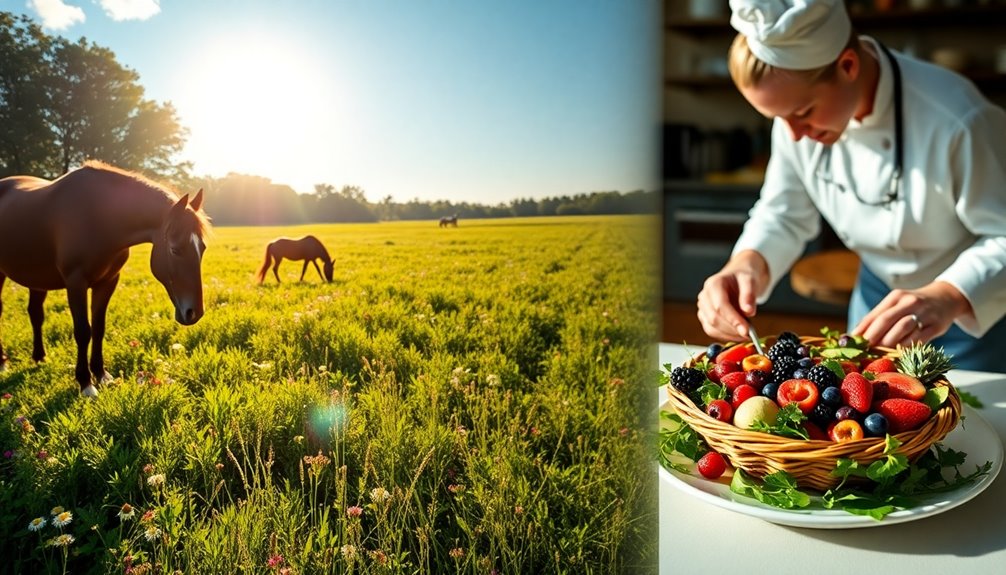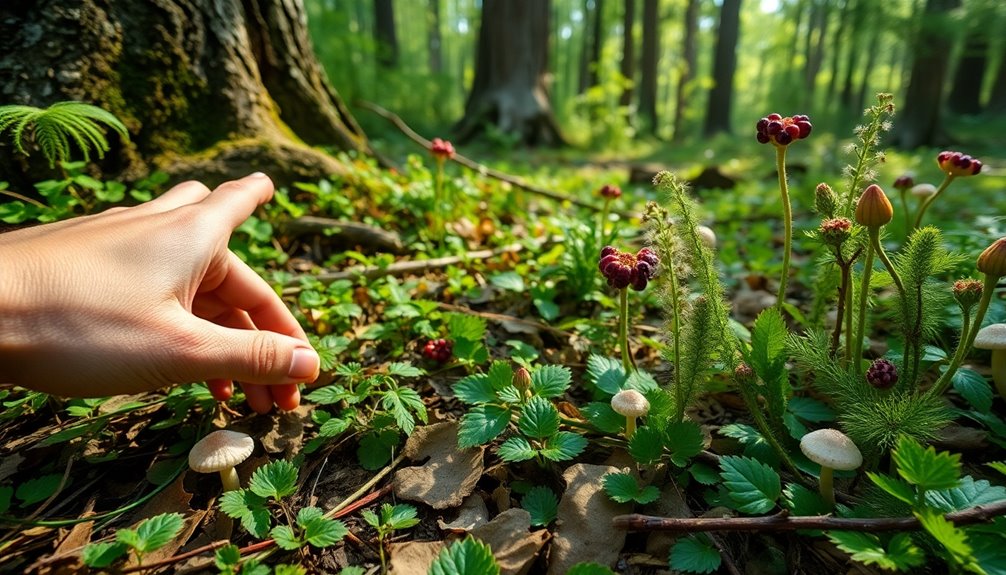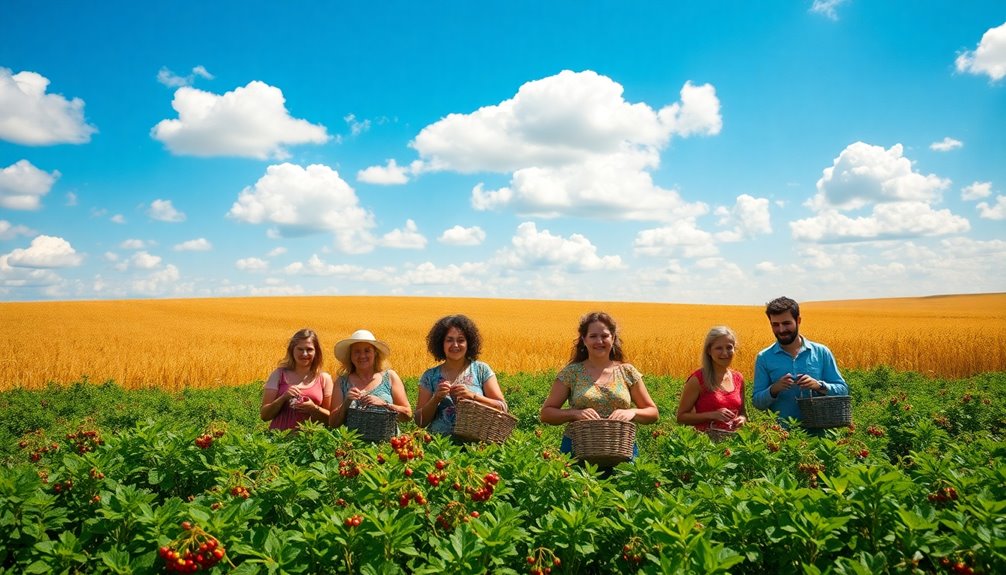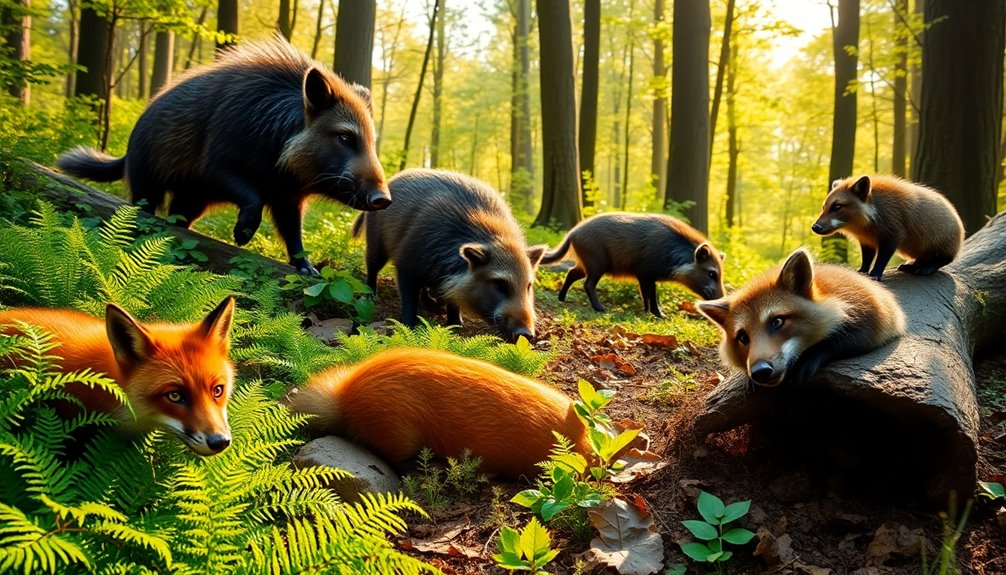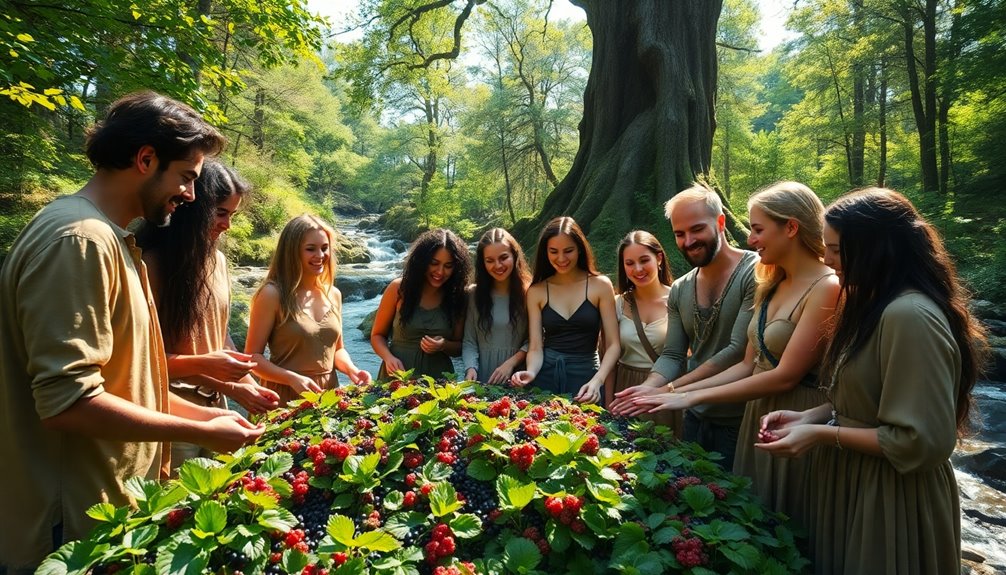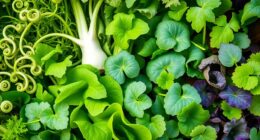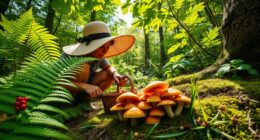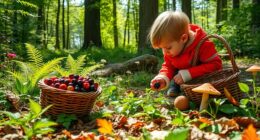Forage can mean several things, depending on the context. Primarily, it refers to food for livestock, essential for their health and productivity. It also describes the act of searching for food, applicable to both animals and humans. In nature, animals forage seasonally based on food availability. Humans use various techniques to gather edible plants while ensuring sustainability and safety. Additionally, forage has economic implications, affecting livestock costs and agricultural communities. The term even appears in cultural references that highlight survival themes. Keep exploring to uncover more about these fascinating dimensions of forage!
Key Takeaways
- Forage primarily refers to food for livestock, significantly impacting their health, growth rates, and productivity in agriculture.
- The term also describes the act of searching for food, applicable to both animals and humans.
- In animals, foraging behaviors vary by species, season, and environmental factors, influencing their dietary choices and hunting strategies.
- Humans engage in foraging for wild foods, requiring knowledge of plant identification and sustainable practices to avoid toxic species.
- Forage management affects economic stability in agriculture, impacting livestock feed costs and contributing to environmental sustainability through improved soil health and biodiversity.
Definition of Forage
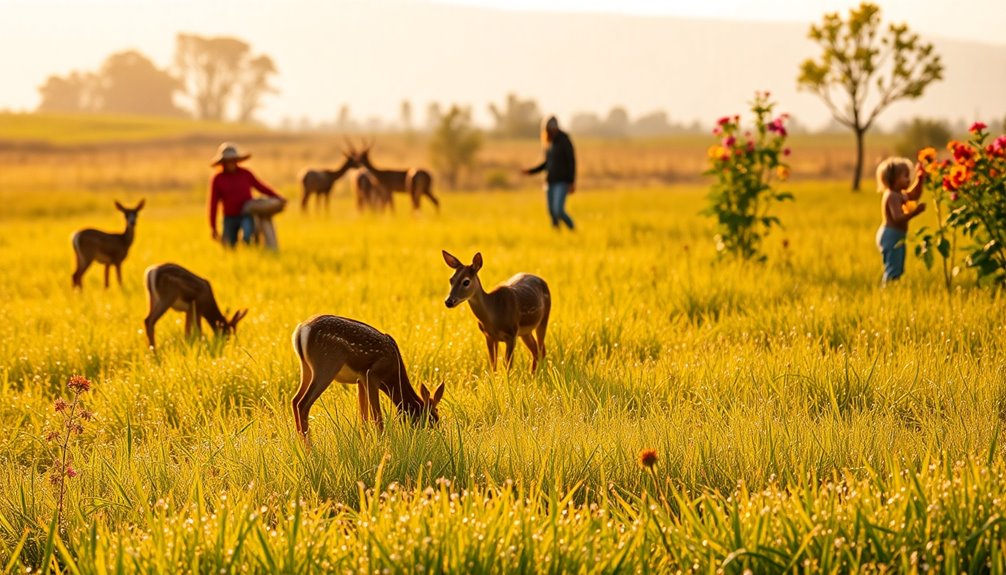
Forage refers to food primarily intended for livestock, including essential plants like grasses and legumes that provide significant nutrition. When you think of forage, it's easy to see it as just feed for animals, but the term also describes the act of searching for food or provisions. This behavior isn't limited to livestock; humans have foraged throughout history, showing an instinctual drive to seek sustenance.
In agriculture, forage plays an important role in livestock health and productivity. It directly impacts growth rates and milk production, meaning farmers must understand what forage is and how to provide it effectively. The variety of foraging behavior among species is fascinating, as environmental factors and food availability shape their survival strategies.
You might find it interesting that the word "forage" has its origins in the Old French word "fourrage," appearing in English since the late 13th century. This long-standing relevance reflects how integral foraging has been in agricultural practices.
Foraging in Animals
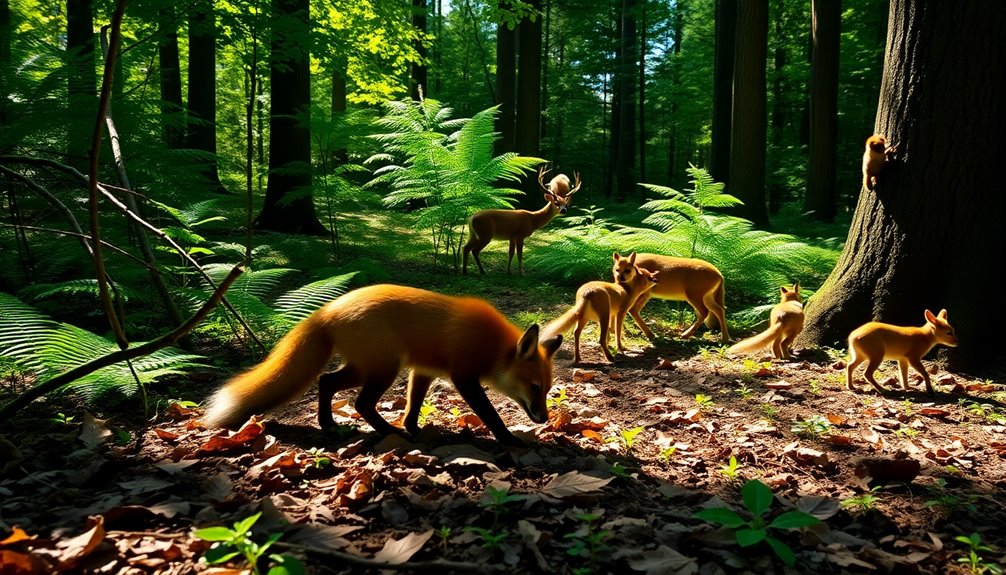
When you observe animals foraging, you'll notice how their behaviors change based on the season and available resources.
For instance, some species may focus on fruits during warmer months while others graze on grasses throughout the year.
This variability in foraging patterns not only showcases their adaptability but also highlights the importance of environmental cues in their survival. Additionally, different regions offer unique foraging opportunities, such as Minnesota's wild edibles like wild leeks and blueberries, which attract various animal species.
Foraging Behavior Variability
Animal foraging behavior showcases remarkable variability across species, with different dietary needs and ecological adaptations shaping how they search for food. For instance, herbivores like deer primarily browse leaves and shrubs, while omnivores such as bears search for fruits, nuts, and small animals.
You'll notice that environmental factors, like habitat type and seasonality, greatly influence these behaviors. Animals adapt their foraging strategies based on resource availability.
Social structures also play a pivotal role. Pack hunters, like wolves, coordinate their efforts to hunt larger prey, while solitary foragers, such as raccoons, rely on their dexterity to scavenge.
This variation in foraging strategies reflects the diverse challenges animals face in their habitats. Learning and experience further contribute to foraging efficiency. Young animals often learn from older individuals, refining their skills in locating and obtaining food.
Additionally, the risk of predation shapes how and when animals forage. Many adopt cautious behaviors or forage during specific times of day to minimize exposure to predators.
Seasonal Foraging Patterns
Seasonal changes play an essential role in shaping the foraging patterns of various species. You'll notice that many animals adapt their foraging behavior based on the time of year and the types of food resources available. For instance, herbivores like deer increase their foraging in spring and summer when new growth is abundant, while they cut back in winter due to food scarcity.
Birds ramp up aggressive foraging in the fall to build fat reserves for migration, whereas other species may reduce their activity in colder months. Bears, on the other hand, exhibit heightened foraging behavior in late summer and early fall to prepare for hibernation. This behavior is critical for their survival, highlighting the importance of seasonal foraging patterns in wildlife ecology.
These seasonal patterns also influence reproductive cycles, as animals tend to synchronize breeding with peak food availability for better offspring survival.
| Season | Foraging Behavior | Example Species |
|---|---|---|
| Spring | Increased foraging | Deer |
| Summer | Sustained foraging | Bears |
| Fall | Aggressive foraging | Birds |
| Winter | Reduced foraging | Various herbivores |
| Pre-Hibernation | Heightened foraging | Bears |
Understanding these patterns is vital for wildlife conservation.
Human Foraging Practices
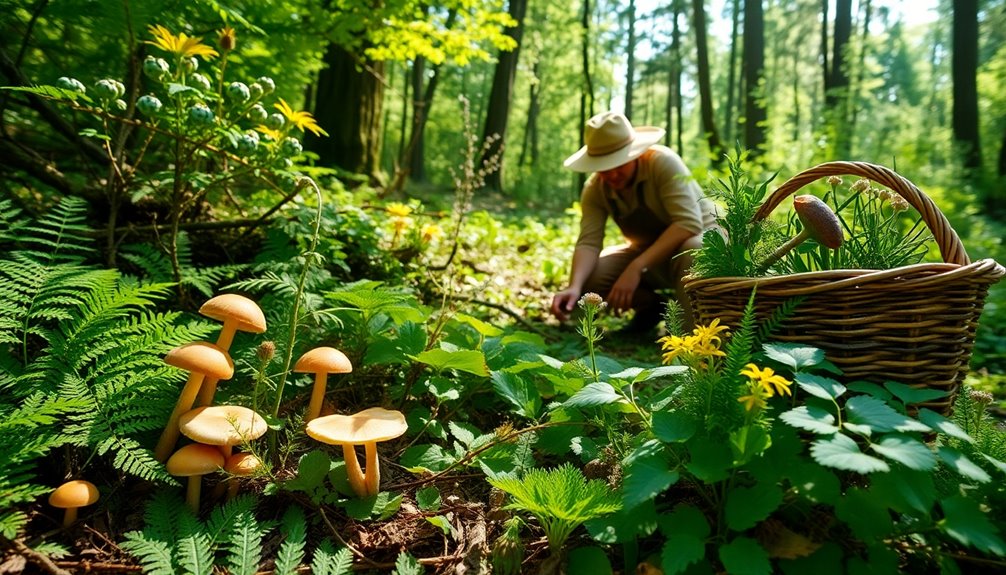
When you explore human foraging practices, you'll discover various techniques for gathering seasonal foods like fruits and nuts.
It's essential to know how to identify safe, edible plants to avoid any health risks.
#
Foraging Techniques and Safety
Foraging for wild edibles can be a rewarding experience, but it also demands careful attention to safety and technique. To guarantee a successful foraging adventure, keep the following essential guidelines in mind:
- Accurate Identification: Always identify plants correctly. Toxic look-alikes can pose serious health risks. Use field guides or mobile apps to help you differentiate between safe and unsafe options.
- Permission and Regulations: Before you set out, check if you have permission to forage in the area. Many parks and nature reserves have strict regulations against harvesting wild plants, and respecting these rules is vital.
- Sustainable Practices: Only take what you need and leave enough behind for wildlife and future growth. This practice supports local ecosystems and guarantees that foraging remains viable for future foragers.
Additionally, always wash and prepare your foraged foods thoroughly to eliminate dirt, pesticides, or contaminants. Keeping in mind the seasonal availability of edible plants can also enhance your foraging success.
Seasonal Food Gathering Opportunities
Exploring the natural world for wild edibles opens up a treasure trove of flavors and nutrition throughout the year. Seasonal foraging allows you to gather a variety of wild foods that change with the seasons. Here's a quick guide to what you can find:
| Season | Wild Edibles | Key Activities |
|---|---|---|
| Spring | Ramps, dandelion leaves, wild greens | Search for tender greens and herbs |
| Summer | Blackberries, blueberries, cherries | Pick berries and explore fruit trees |
| Autumn | Acorns, chestnuts, apples, pears | Gather nuts and harvest late fruits |
| Winter | Kale, wild herbs, edible roots | Look for evergreens and hardy plants |
| Year-Round | Mushrooms, wild garlic | Forage mushrooms and garlic in various seasons |
Engaging in these seasonal practices not only provides you with fresh and nutritious options but also deepens your connection to nature. As you learn about local ecosystems, you promote biodiversity awareness and cultivate a sustainable relationship with the environment. So, grab a basket and start your foraging adventure!
Economic and Environmental Impact
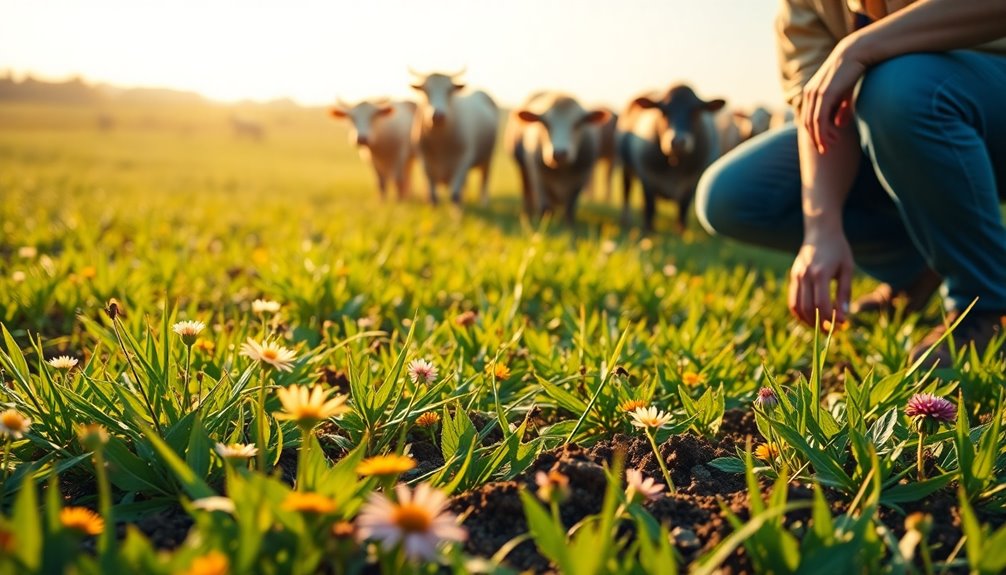
The interplay between forage quality and availability greatly shapes both economic stability and environmental health in agricultural communities. When forage conditions worsen, it directly affects livestock health, leading to increased feed costs that can skyrocket by up to 30% during droughts.
Sustainable forage management practices, like rotational grazing, not only enhance soil health but can also boost biodiversity, potentially sequestering up to 1.1 billion tons of carbon annually in the U.S.
Here are three key impacts of forage on economic and environmental aspects:
- Economic Contribution: Forage crops generate over $10 billion annually for the U.S. agricultural economy, supporting livestock feed and related markets.
- Ecosystem Resilience: Diverse forage options improve livestock productivity while reducing vulnerability to pests and diseases, promoting a healthier ecosystem.
- Food Security: During extreme weather events, forage scarcity can lead to heightened food insecurity in local populations, as livestock production declines and feed prices surge. Pet therapy can support livestock health by promoting better emotional well-being during challenging agricultural periods.
Understanding these dynamics helps you appreciate how crucial forage is in maintaining both economic viability and environmental sustainability in agriculture.
Cultural References and Literature

Drawing from various cultural references and literary works, foraging often serves as a powerful metaphor for the human experience, reflecting our innate quest for sustenance and meaning. In Cole Matthews' story, foraging symbolizes the struggle for survival and the quest for identity amid adversity. You see how characters grapple with their circumstances, seeking not just food but also a sense of self.
In "The One and Only Ivan," foraging highlights the instinctual behaviors of animals in captivity, emphasizing their deep longing for freedom and natural habits. This illustrates how foraging connects to a broader desire for liberation and authenticity.
Meanwhile, in "The Hunger Games" series, characters must forage for food in a dystopian landscape, showcasing resourcefulness and resilience in dire situations. Each moment of searching for sustenance becomes a fight for survival and hope.
Through these narratives, foraging transcends its literal meaning, reflecting humanity's timeless quest for meaning and connection to nature. Cultural references to foraging also remind us of historical practices, underscoring our intrinsic link to the natural world across various literary traditions. Additionally, the concept of proper diet emphasizes how foraging relates to the nutritional needs of both humans and animals, highlighting the importance of understanding our environment.
Consequently, foraging becomes a symbol of life's profound search for purpose.
Forage in Agriculture
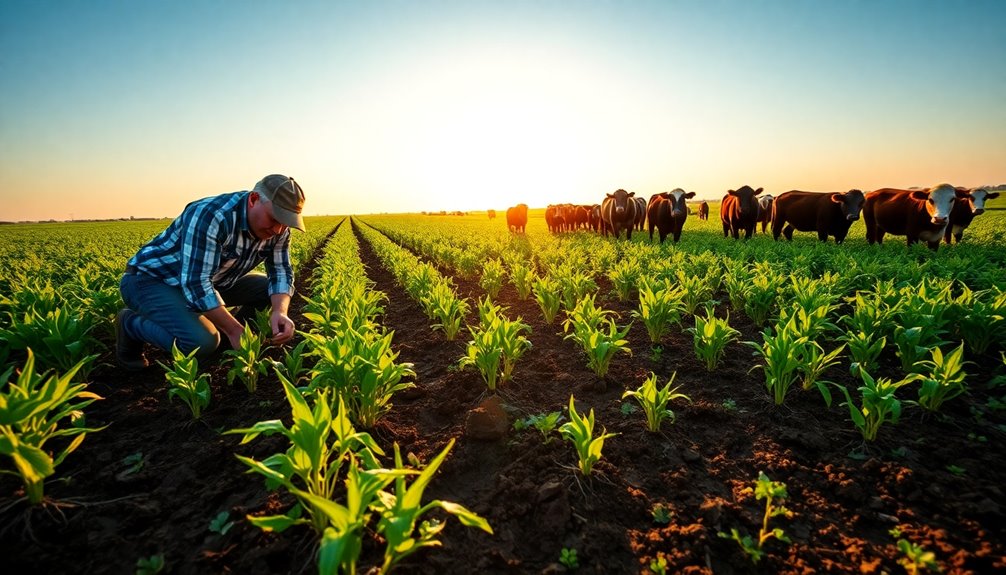
Forage plays a significant role in agriculture, providing essential plant materials like grasses and legumes that nourish livestock.
By ensuring that livestock receive the right nutrients, you're contributing to their growth, milk production, and overall health. Managing forage effectively is fundamental for successful animal husbandry.
Here are three key points to take into account:
- Quality and Availability: The quality of forage directly impacts livestock productivity. Ensuring a consistent supply of high-quality forage can minimize feed costs and enhance animal performance.
- Sustainable Practices: Implementing rotational grazing helps maintain soil health and promotes plant regeneration. This practice not only benefits your livestock but also supports the long-term sustainability of your agricultural system.
- Biodiversity: Diverse forage options enrich agricultural ecosystems. By cultivating a variety of plants, you contribute to environmental conservation and promote a balanced ecosystem that benefits both livestock and the surrounding environment.
Synonyms and Related Terms
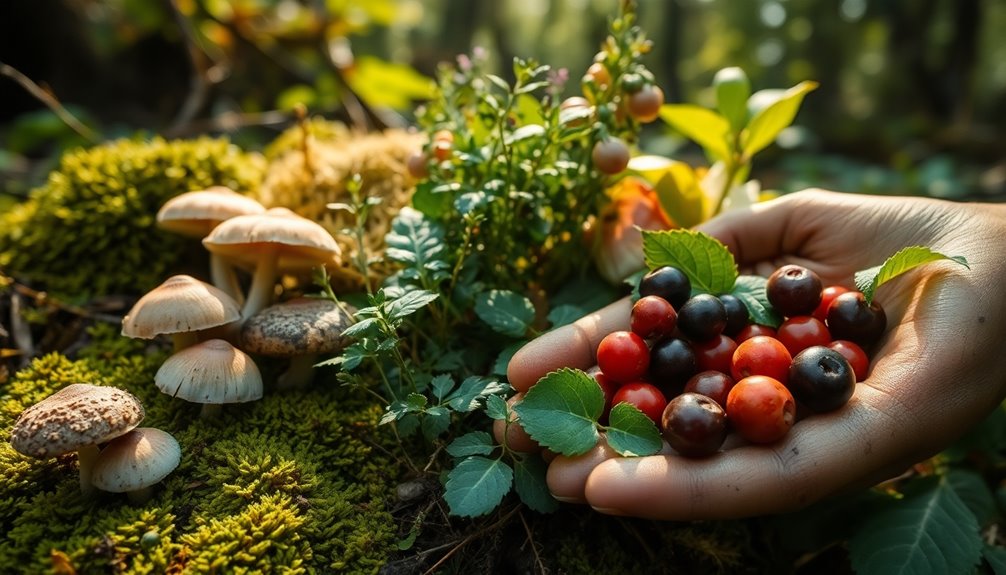
Understanding synonyms and related terms for "forage" can enhance your grasp of its various meanings and applications. When you think of "forage," consider words like "search," "hunt," "scavenge," and "rummage." Each of these captures a unique aspect of seeking food or provisions.
For example, "search" suggests a more general seeking, while "scavenge" often conveys a sense of desperation, especially in scarce conditions.
In agriculture, related terms like "fodder," "feed," and "provender" specifically refer to food provided to livestock. This highlights the importance of context when discussing animal care and feeding practices.
The term "foraging behavior" is also significant in ecological discussions, as it refers to strategies animals use to locate food, underscoring its relevance in animal ecology studies.
## Foraging Techniques and Safety

When venturing into the world of foraging, it's vital to prioritize safety and proper techniques. Knowing how to identify edible plants is your first line of defense against toxic look-alikes. Many wild plants have poisonous counterparts that can lead to serious health issues, so don't take any chances.
Here are three essential tips to keep in mind:
- Choose Safe Locations: Always forage in areas free from pesticides, herbicides, and pollutants. Chemicals can accumulate in wild plants, compromising their safety and quality.
- Forage Sustainably: Take only what you need and leave enough for wildlife and future growth. This practice helps maintain healthy ecosystems and guarantees that resources remain available for others.
- Practice Hygiene: Wear gloves while foraging and wash all gathered items thoroughly before consumption. This reduces the risk of contamination from dirt, insects, or bacteria.
Educational Resources for Foraging
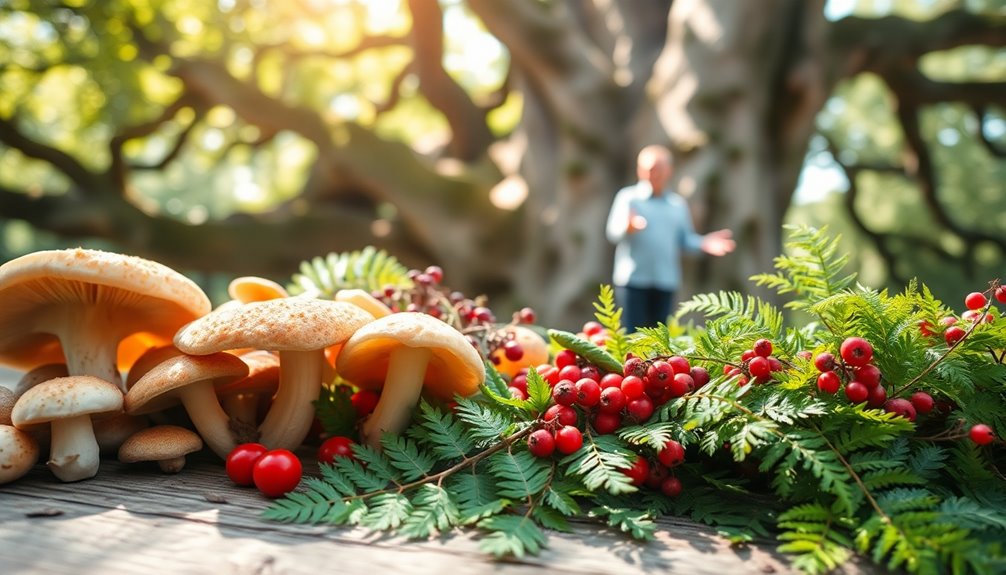
Exploring the world of foraging becomes even more rewarding with the right educational resources at your fingertips. Guides that help you identify edible plants and mushrooms are essential, ensuring you know what's safe to eat.
Look for online platforms and community workshops that offer interactive learning experiences, allowing you to gain hands-on skills in foraging within your local ecosystem.
Many universities and agricultural organizations also provide courses focused on sustainable foraging. These courses emphasize the importance of biodiversity and the ecological impact of gathering food, helping you become a responsible forager.
Additionally, consider downloading mobile apps dedicated to foraging, which can assist you in identifying plants and tracking seasonal availability. This tech-savvy approach enhances your knowledge while prioritizing safety.
Don't overlook the wealth of books and field guides available. They offer detailed descriptions, illustrations, and recipes for wild edibles, making foraging accessible to both beginners and seasoned enthusiasts.
Moreover, learning about mushroom foraging techniques can significantly improve your skills and confidence in identifying various edible fungi.
With these resources, you can deepen your understanding of foraging and connect more meaningfully with nature. So, immerse yourself in these educational tools, and start your foraging journey with confidence!
Frequently Asked Questions
What Is the Meaning of Forage in One Word?
The meaning of "forage" in one word is "search."
When you forage, you actively seek out food or resources, whether it's animals grazing in a field or you gathering wild mushrooms in the woods.
It often implies a need, sometimes driven by necessity. You could be scavenging for supplies or simply exploring nature for edible treasures.
What Is Considered a Forage?
Forage refers to any plant material that animals consume, like grasses, legumes, and other greenery.
When you think about what's considered forage, you're looking at food sources for livestock and wildlife that support their growth and health.
Seasonal changes can affect what's available, so you'll need to adjust your feeding strategies accordingly.
Foraging also connects to gathering wild edible plants for humans, highlighting the importance of plants in both diets.
What Is Foraging in Simple Words?
Foraging is simply searching for and gathering food from nature. You look for wild plants, fruits, or mushrooms, often enjoying the thrill of discovering something tasty and fresh.
It's a way to connect with the environment and appreciate where your food comes from. As seasons change, different foods become available, so you adapt your foraging habits.
Whether for survival or fun, foraging helps you engage with local ecosystems and sustainable practices.
Does Forage Mean Search?
Imagine you're wandering through a forest, looking for wild berries. Within this framework, yes, "forage" does mean to search.
You actively seek out food, whether it's fruits, nuts, or edible plants. It's not just about finding something to eat; it's about exploring and discovering what nature offers.
Conclusion
In exploring the many contexts of "forage," you might think it's just about animals searching for food, but it's so much more! Foraging connects us to nature, enhances our diets, and fosters a deeper appreciation for the environment. Whether you're harvesting wild herbs or learning sustainable practices, foraging can enrich your life in unexpected ways. So, why not step outside and discover the bounty around you? You'll find that foraging is an adventure waiting to unfold!

